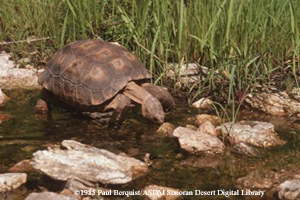Animal Fact Sheet: Desert Tortoise |
Identifying Features Desert tortoise (Gopherus morafkai) have a high domed shell, carapace (top of shell) length of 9 to 15 inches, elephantine or "columnar" legs that are heavily scaled in the front. A desert tortoise can't be mistaken for anything else native to its range (introduced tortoise species complicate this).
|
 |
Adaptations Desert tortoise are able to burrow to escape heat. They can store water in their bladder, and are able to tolerate high levels of urea in their blood to keep from losing moisture through excess urinating. They can go for long periods of time without food or water. |
Habitat In California, the desert tortoise is most often found in open washes in creosote-bush flats. The eastern Sonoran Desert populations most often occur in rocky canyons and hillsides. It is most common in the desert, but also occurs in tropical deciduous forest and some grassland habitats. |
Range The desert tortoise is found in eastern California, southern Nevada, southwestern Utah, western and southern Arizona, and Sonora, Mexico. |
Wild Status The Mohave Desert population is listed as threatened by the federal government. That population and all other desert tortoises are protected by the states where they occur. Habitat destruction, introduced grasses, disease, low reproductive rates and illegal taking for pets have contributed to its decline. |
Diet Desert tortoises are herbivores. They feed on various plants depending upon their seasonal variability: annuals, grasses, herbs, flowers, some cacti and their fruits. They can also eat dry forage. |
Predators Ravens, gila monsters, kit fox, badgers, roadrunners and coyotes are all predators of the desert tortoise. They prey on the juveniles, which are 2 to 3 inches long and have thin, delicate shells. Mountain lions may occasionally take adult tortoise |
Home Tortoises live in burrows that they construct in the sides of washes, hillsides, rock overhangs, or crevices in rocky areas. Some construct shallow "pallets" to rest in during the day, usually beneath shrubs, overhangs, or other shelter. |
Life Span In the Sonoran Desert, wild tortoises can live about 35 or 40 years although some live to be much older. |
Size An adult desert tortoise can measure up to 14 inches (35.5cm) in length. Hatchlings are only 2 to 2 1/2 inches (5 to 6.5 cm) long. |
Extra Fun-facts
|
 ©Copyright 2008, Arizona-Sonora Desert Museum
©Copyright 2008, Arizona-Sonora Desert Museum